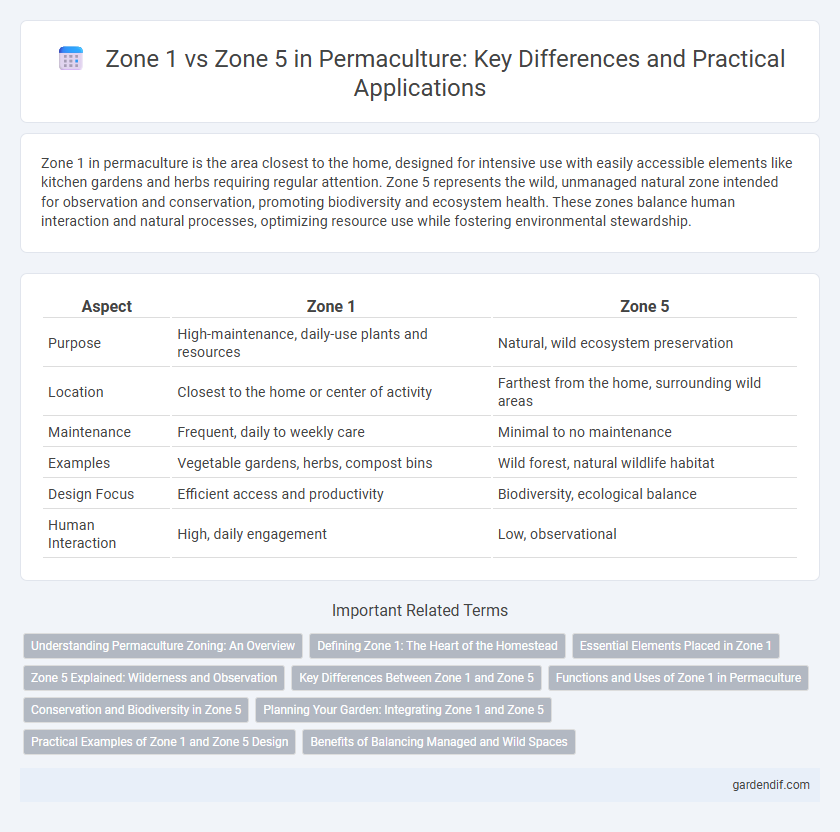
Zone 1 vs Zone 5 (Permaculture Zones) Illustration
Zone 1 in permaculture is the area closest to the home, designed for intensive use with easily accessible elements like kitchen gardens and herbs requiring regular attention. Zone 5 represents the wild, unmanaged natural zone intended for observation and conservation, promoting biodiversity and ecosystem health. These zones balance human interaction and natural processes, optimizing resource use while fostering environmental stewardship.
Table of Comparison
| Aspect | Zone 1 | Zone 5 |
|---|---|---|
| Purpose | High-maintenance, daily-use plants and resources | Natural, wild ecosystem preservation |
| Location | Closest to the home or center of activity | Farthest from the home, surrounding wild areas |
| Maintenance | Frequent, daily to weekly care | Minimal to no maintenance |
| Examples | Vegetable gardens, herbs, compost bins | Wild forest, natural wildlife habitat |
| Design Focus | Efficient access and productivity | Biodiversity, ecological balance |
| Human Interaction | High, daily engagement | Low, observational |
Understanding Permaculture Zoning: An Overview
Permaculture zoning divides a landscape into five distinct areas based on usage intensity and frequency, with Zone 1 being the closest to the home for daily maintenance and Zone 5 as the wild, unmanaged natural area promoting biodiversity. Zone 1 typically includes herb gardens, compost bins, and water sources, while Zone 5 serves as a conservation area supporting native plants and wildlife. Understanding these zones optimizes resource efficiency, enhances ecological balance, and maximizes productivity in permaculture design.
Defining Zone 1: The Heart of the Homestead
Zone 1 in permaculture is the area closest to the home, designed for intensive cultivation of high-maintenance plants such as herbs, salad greens, and vegetables that require daily attention. This zone prioritizes accessibility, ensuring efficient harvesting, watering, and maintenance to maximize productivity with minimal effort. Strategically placing compost bins, rainwater collection systems, and frequently used tools within Zone 1 enhances sustainability and reduces energy expenditure.
Essential Elements Placed in Zone 1
Zone 1 in permaculture design houses essential elements requiring frequent attention, such as kitchen gardens, herb beds, and compost bins, optimizing daily access and maintenance. Placing water sources, tool storage, and frequently harvested plants close to living areas reduces energy expenditure and enhances efficiency. This strategic organization contrasts with Zone 5, which remains a wild, unmanaged area promoting biodiversity and ecological observation.
Zone 5 Explained: Wilderness and Observation
Zone 5 in permaculture represents the wilderness area, left largely undisturbed to promote natural ecosystems and biodiversity. It serves as a critical zone for observation, allowing practitioners to study natural patterns, soil health, native flora and fauna, and weather conditions that inform sustainable design decisions. Maintaining Zone 5 fosters ecological balance and provides a baseline for regenerative practices in more intensively managed zones.
Key Differences Between Zone 1 and Zone 5
Zone 1 in permaculture is the area closest to the home, designed for intensive cultivation of herbs, vegetables, and frequently harvested plants to maximize accessibility. Zone 5 is a wild, unmanaged natural zone intended for observation, biodiversity conservation, and ecosystem regeneration, with minimal human intervention. Key differences include human activity intensity, plant selection, and management goals, where Zone 1 emphasizes productivity and Zone 5 prioritizes natural processes.
Functions and Uses of Zone 1 in Permaculture
Zone 1 in permaculture primarily functions as the area for daily human interaction and intensive cultivation, including kitchen gardens, herb spirals, and composting systems. It is designed for high-maintenance plants and frequent harvesting, maximizing productivity and resource efficiency close to the home. This proximity supports efficient energy use and facilitates continuous observation, ensuring optimal plant health and system resilience.
Conservation and Biodiversity in Zone 5
Zone 5 in permaculture is dedicated to natural conservation and biodiversity, serving as a wild, unmanaged area that supports native flora and fauna. Its preservation promotes ecosystem health by maintaining habitat diversity, enhancing pollinator populations, and facilitating natural processes like nutrient cycling. Unlike Zone 1, which is intensively managed for food production, Zone 5 focuses on ecological balance and resilience through minimal human intervention.
Planning Your Garden: Integrating Zone 1 and Zone 5
Planning your garden by integrating Permaculture Zone 1 and Zone 5 maximizes resource efficiency and ecological harmony. Zone 1, closest to the home, is ideal for intensive vegetable beds, herbs, and daily-use plants, ensuring ease of access for regular maintenance and harvesting. Zone 5, the wild or natural area, supports biodiversity, habitat restoration, and passive energy management, creating a balance between cultivated and natural ecosystems that enhances overall garden resilience.
Practical Examples of Zone 1 and Zone 5 Design
Zone 1 in permaculture design typically includes areas closest to the home, such as kitchen gardens with herbs, salad greens, and frequently harvested vegetables to maximize convenience and efficiency. Zone 5 represents the wild, unmanaged natural area reserved for observation and biodiversity, often left as a woodland or native habitat supporting wildlife and ecological balance. Practical examples of Zone 1 design feature raised beds, compost bins, and rainwater catchment systems, while Zone 5 designs emphasize preserving native plant species, fostering wildlife habitats, and monitoring natural ecological processes.
Benefits of Balancing Managed and Wild Spaces
Balancing Zone 1 and Zone 5 in permaculture maximizes productivity by integrating intensively managed areas near the home with minimally disturbed natural ecosystems, enhancing biodiversity and ecosystem services. Zone 1 supports daily activities such as vegetable gardening and herb cultivation, providing fresh, accessible food sources, while Zone 5 preserves wildlife habitats and promotes natural regeneration. This synergy reduces resource inputs, improves soil health, and fosters ecological resilience within the landscape.
Zone 1 vs Zone 5 (Permaculture Zones) Infographic

 gardendif.com
gardendif.com